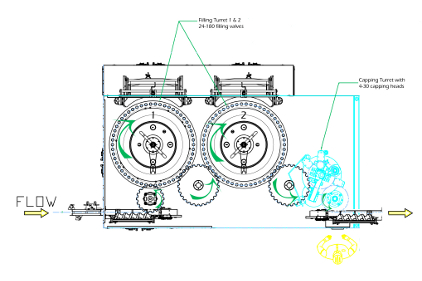Fogg Filler(www.foggfiller.com), a market leader in the design and manufacture of rotary filling systems for the liquids industry, is continually focused on improving technology that better serves our customers and the environment. Fogg has developed a revolutionary filler that has two filling bowls on one filler base with one capper. This new combination allows for a lower initial investment, lower ceiling height requirements, smaller floor space requirements, and more manageable maintenance.
When you have high capacity filling requirements of slow filling bottles (example: 28mm glass, 750ml wine or spirits), you often times end up with one very large filling bowl and a very large capper to match the geometry. The capper will run at about 50% capacity while the other 50% is wasted just because of the size requirements of the large filling bowl. So, to combat this capping capacity loss, Fogg has optioned twin smaller bowls that will fill faster than one big filling bowl while using 100% of the capper’s capacity at the same time This change will actually save you 10-40% in your initial investment.
The twin filling bowls reduce your waste rates. Two twin F6.2 filling bowls have a combined maximum capacity of 340 gallons while large fillers can exceed a capacity of 400 gallons. This is a 15%-20% volume reduction which is very helpful when maintaining temperatures and flavor changes. There is also CIP savings as your system can be much smaller when you CIP two twin F6.2 bowls over one large one.
Floor space is always a concern. The twin bowl layout comes in about two feet narrower than a competitive single bowl machine layout. It is also about four feet shorter. This will allow for a much more manageable installation into an existing plant that has lots of piping, wiring, elevated walkways, and other height restrictions. Many replacement machines’ floor space there is line length available but not width because of other adjacent installed equipment.
Maintenance is less intense. Having twin filler bowls will allow two operators to simultaneously work on the filler’s change over and maintenance. All the change parts will be considerably smaller and more manageable, as well as its maintenance.




